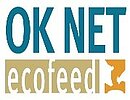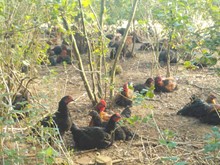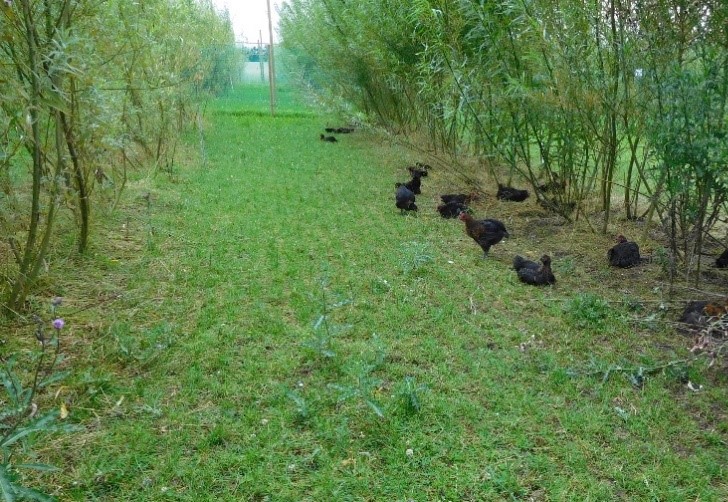Foraging of broilers in outdoor areas
Problem
Access to outdoor areas is mandatory in organic poultry production. Stimulating organic broilers to use outdoor areas can be a challenge if there is only sparse vegetation without trees and bushes outside the houses.
Solution
Establishing attractive areas is necessary to increase the number of broilers going outside. A combination of smaller open areas with grass and herbs as well as areas with different bushes and trees, where the broilers can feel safe, will stimulate the chickens to use a larger part of the outdoor areas (see figure 1). Choice of geno-types can be important, as some genotypes are more active than others.
Benefits
Having access to an attractive outdoor area will stimulate the broilers to be more active and forage, which contributes to a more natural behaviour. Active broilers are expected to have fewer food pad lesions, which is important for the birds' welfare. In addition to higher activity, grass, herbs and/or crops in the outdoor area can provide the birds with nutrients.
Applicability box
Geographical coverage
Global
Application time
Outdoor areas can be used all year round; how-ever, in a colder climate, winter periods can be difficult and winter gardens are recommended.
Required time
Planting outdoor areas takes time and new bushes and trees as well as grass/herbs have to be protected from birds for 1 to 2 years.
Period of impact
The planting period is critical. Newly planted trees or bushes can be protected by fencing.
Equipment
Equipment for planting trees and bushes, mova-ble fences
Best in
Slow-growing trees, e.g. fruit trees, can be shel-tered by fast-growing nurse trees, e.g. willow or poplar. Planting time will depend on climate and weather conditions.
Practical Recommendations
- Select plant species that are robust and adjusted to the climate such as caraway (Carum carvi), red clover (Trifolium pratense), chicory (Cichorium intybus), plantain (plantago major (broadleaf)/Plantago lanceolate (lancetleaf), ryegrass (Lolium perenne), selfheal (Prunella vulgaris), birdsfoot trefoil (Lotus corniculatus), lucerne/alfalfa (Medicago sativa).
- Fencing off part of the plants might be necessary until they have reached a size that makes them less vulnerable to birds eating leaves and smaller branches.
- Planting some trees in rows from the broiler houses will encourage the birds to leave the house and spread far into the outdoor areas (see figure 2).
- Combine trees and bushes with smaller open areas with grass/herbs or even crops that encourage foraging activity and other natural behaviour such as dustbathing, which is good for animal welfare.
- Choice of genotype is important. Very fast growing genotypes are not suitable for establishing a population with active animals.
- During cold winter periods, broilers are less motivated to go outside; a veranda system (winter garden), where silage can be provided, is recommended.
Further information
Reading
- Steenfeldt, Sanna (2014) Chickens foraging in the woods. DCA's monthly external newsletter, June 2014, Available at http://orgprints.org/28724/1/28724.pdf
- Steenfeldt, Sanna Diversitet og integritet i økologisk slagtefjerkræproduktion- MultiChick, Aarhus Universitet. Available at http://icrofs.dk/fileadmin/icrofs/Nyheder_PDf/MultiChick/MultiChick_folder_Final.pdf
- Almeida, G. et al. (2012) Feed intake and activity level of two broiler genotypes foraging different types of vegetation in the finishing period. Poultry Science 91(9):2105-13. DOI:10.3382/ps.2012-02187
- Check the Organic Farm Knowledge platform for more practical recommendations on animal husbandry.
About this practice abstract and OK-Net EcoFeed
Publishers:Dept. of Animal Science (ANIS). Aarhus University (AU),
DK8830Tjele,
Phone +45 8715 6000/+45 8715 8074,
,
anis.au.dkResearch Institute of Organic Agriculture (FiBL),
CH5070Frick,
Phone +41 62 865 72 72,
info.suisse@fibl.org,
www.fibl.orgIFOAM Organics Europe,
BE1000Brussels,
Phone +32 2 280 12 23,
www.organicseurope.bio,
www.organicseurope.bio
Contact: sanna.steenfeldt@anis.au.dk
Permalink: https://organic-farmknowledge.org/tool/35469
https://orgprints.org/view/projects/OKNetEcoFeed.html
This practice abstract was elaborated in the Organic Knowledge Network on Monogastric Animal Feed project. The project is running from January 2018 to December 2020. The overall aim of OKNet EcoFeed is to help farmers, breeders and the organic feed processing industry in achieving the goal of 100% use of organic and regional feed for monogastrics.
Project website: https://ok-net-ecofeed.eu/
IFOAM Organics Europe (project coordinator), BE; Aarhus University (ICROFS), DK; Organic Research Centre (ORC), UK; Institut Technique de l'Agriculture Biologique (ITAB), FR; Research Institute of Organic Agriculture (FiBL), CH; Bioland, DE; Associazione Italiana perl'Agricoltura Biologica (AIAB), IT; Donau Soja DS, AT; Swedish University of Agricultural Sciences, SE; ECOVALIA, ES; Soil Association, UK.



This project has received funding from the European Union’s Horizon 2020 research and innovation programme under grant agreement No 773911. This communication only reflects the author’s view. The Research Executive Agency is not responsible for any use that may be made of the information provided. The authors and editors do not assume responsibility or liability for any possible factual inaccuracies or damage resulting from the application of the recommendations in this practice abstract

